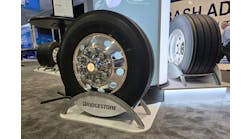With margins that are often thin and a need to boost profitability, fleet executives are looking for solutions to reduce maintenance costs while keeping vehicles safe and properly maintained. They see increasing uptime, saving money, and ensuring safety as three of their most important goals.
Today, technology is enabling fleets to move beyond relying only on scheduled preventive maintenance and their drivers communicating maintenance issues to keep costs down. One of the most powerful technologies aiding maintenance, both in the shop and on the road, is telematics.
Telematics is the integrated use of communications and information technology to transmit, store, and receive data from remote objects – in this case, trucks and trailers – over a network. In practical terms, telematics means a fleet no longer must wait for a vehicle to pull into a shop – or worse, break down on a road – before an equipment issue is reported by a driver or discovered by a technician.
Telematics has been embraced as an asset by many fleets looking for ways to increase efficiency, enhance performance, and maximize safety. Telematics solutions are data-driven monitoring systems that work in real time and use algorithms and machine learning to predict an outcome – a form of artificial intelligence (AI).
Armed with such AI capability, fleets gain a predictive maintenance tool that helps them determine future component or vehicle system failures. When maintenance can be performed as needed or ahead of schedule, fleets can avoid unplanned downtime.
Predictive maintenance provides a higher level of detail to fleets than interval-based maintenance programs, where decisions are driven by time and mileage considerations. When a fleet uses predictive maintenance, they can perform maintenance, repairs, and component replacements before a vehicle breaks down, or simply make adjustments ahead of a scheduled maintenance interval.
When implementing predictive maintenance practices, fleets should look for solutions that monitor the health and safety of the vehicle and allow issues to be detected early before they escalate into costly repairs.
Within smart components and systems onboard today’s vehicles, sensors quickly and efficiently transmit data to the system’s user interface in real time. The user interface then converts the real-time data from the sensors into a usable, actionable format that can be understood by fleets and drivers. The user interface alerts the fleet or driver of unusual wear, failure, or other values outside of normal operating parameters that could indicate a future breakdown, allowing the fleet to schedule preventive maintenance early.
Sensors are being used to monitor more components on today’s tractors and trailers. This allows fleets and drivers to have access to more data and become aware of the need to repair or replace a component immediately.
Telematics and the braking system
As the industry moves forward toward greater use of predictive maintenance, many fleets are looking to their telematics provider for a dashboard of critical operating components. A key benefit to using this technology is that remote sensing in real time can monitor the status of vehicle braking systems, one of the most critical items on both the truck and the trailer.
Because the proper function of braking systems can be affected by inadequate maintenance and inspection procedures, fleets often face unscheduled repairs and downtime, increased fuel costs, higher operating costs, and even accidents. Brakes functioning at suboptimal levels will not do the job they are designed to do and will not be as effective when needed, especially in a panic stop.
A new type of sensor system looks to alleviate these concerns by monitoring the braking system to ensure that brakes are functioning properly. TSE Sense, one such system, uses proprietary software that analyzes brake data for real-time response to provide fleets with predictive or preventive diagnostics.
The collected data from each brake actuator sensor sends regular updates to the telematics user interface and can provide real-time status for key parameters.
Brake monitoring systems can indicate out-of-stroke brakes, dragging brakes, non-functioning brakes, emergency spring failure, cross-axle brake imbalance, and brake performance variations among wheel ends. Because they track these braking events in real time, fleets can predictively maintain brake systems.
The TSE system is comprised of smart brake actuators and a data integration box (DIB), which allow the system to continuously monitor brake stroke at each wheel end and emergency spring condition. Brake performance data is logged in the DIB, where it is collected and sent to the user interface.
By understanding the historical data relative to the brake chamber and its interaction with the brake adjuster, braking system monitors can provide feedback in advance of a potential out-of-service violation. In addition, they can alert fleets and drivers to when service should be performed on a truck or trailer based on the application and its scheduled time for maintenance.
Benefits of brake monitoring
Monitoring a vehicle’s braking system can show patterns of performance that may indicate brake safety issues. In addition, brake system monitoring can:
- Increase fuel efficiency and reduce operating costs by alerting fleets to brake drag, which increases wheel-end rolling resistance. Correcting this to reduce rolling resistance lowers fuel usage, resulting in better fuel efficiency.
- Reduce unscheduled repairs and downtime by monitoring whether the pushrod stroke of each brake chamber is functioning properly. If the stroke length is increasing or is out of adjustment, repairs can be performed, which may also prevent downtime due to “brakes out of service” situations based on DOT inspection parameters.
- Provide notice of an “out of stroke” condition for the brake, a key item in every DOT inspection.
- Reduce accidents by enabling users to identify and repair a brake issue before it impacts the brake system’s function.
With the increased use of telematics on commercial vehicles, braking system monitors that provide real time and historical data can be leveraged to develop predictive maintenance schedules for trucks and trailers.
With over 13 years in the commercial vehicle market, Darin Cate has been vice president of engineering for two years at TSE Brakes. Cate’s team at TSE concentrates on product launches in addition to testing and researching potential brake products that will provide performance and fuel efficiency to trucks and trailers. Prior to joining TSE Brakes, Cate had over ten years of engineering experience at Performance Friction Corporation (PFC) in Clover, South Carolina. He earned his master’s degree in mechanical engineering at Colorado State University, and his Bachelor of Science degree in engineering at the University of Tennessee at Martin. Cate authored an SAE paper in 2008.




